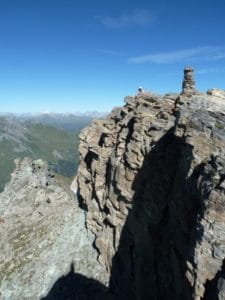
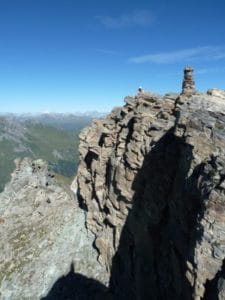 Botanist working on Piz Tomuel in Safiental Switzerland in 2010. Photo: Sonja Wipf/SLF, Switzerland.
Botanist working on Piz Tomuel in Safiental Switzerland in 2010. Photo: Sonja Wipf/SLF, Switzerland.
I was lucky enough to grow up in an academic sense as part of a scientific collaboration that I can call my academic family: the Summit Flora family. Recently, the juiciest fruit of this collaboration was harvested when results from the Summit Flora project were published in Nature (Steinbauer et al. 2018). The analyses, based on 302 botanical resurveys of European mountain summits, show that since the 1870’s the plant species richness on summits has constantly increased. And more strikingly, this increase has accelerated hand in hand with climate warming over the past four decades, the enrichment rate now being five times higher than 50 years ago. Although several studies have suggested the link between warming and the upward migration of alpine species, this is the first time that the role of other potential drivers (precipitation change and nitrogen deposition) was found to be minor compared to that of warming. This is also one of the first publications to show an accelerating response to climate warming in terrestrial ecosystems
Big questions call for large networks
Although this news is easy to read and understand, the hard work behind such simple results may be difficult to see. To test for connections between the past global change and the ecological response, we need data that goes spatially and temporally beyond what has been available until now: long-term data from different regions that have experienced different rates of climate change. And what is needed to achieve this type of data is large, continental or global scale scientific collaboration.
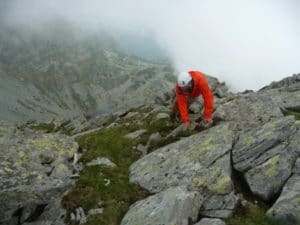 Botanist resurveying Vârful Custura in the Carpathian mountains in Romania in 2014. Photo: Anita Jost, Switzerland.
Botanist resurveying Vârful Custura in the Carpathian mountains in Romania in 2014. Photo: Anita Jost, Switzerland.
For instance, surveying over 300 mountain summits spanning a whole continent cannot be done over one summer season or by one lab alone. When I joined the project as a PhD-student in Davos in 2013, the project already had the nickname Hiking Project. In fact, it took dozens of skilled and passionate trained botanists and a total of 14,988 km of hiking to revisit the 302 summits to gather the data to study the connection between species enrichment and global warming. In total, over hundred experts from 11 European countries were involved in searching for historical data, conducting resurveys, and then cleaning and managing this data, pasting together the long-term climate data, analysing it, and finally writing up the results.
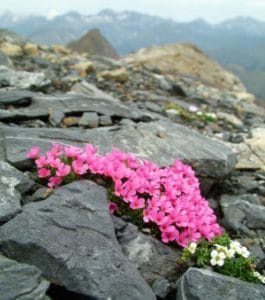 Androsace ciliata and Hutchinsia alpina on Punta Suelza (2972m) in Central Pyrenees. Photo: J.V. Ferrández/ IPE-CSIC, Spain.
Androsace ciliata and Hutchinsia alpina on Punta Suelza (2972m) in Central Pyrenees. Photo: J.V. Ferrández/ IPE-CSIC, Spain.
Keys to blooming collaborations
Large collaborations rarely start from scratch but instead often evolve from existing networks: you invite colleagues you like working with, who then bring new connections with different expertise or from new geographic areas. The Summit Flora family also stemmed from old connections. Maybe we were lucky, but it was clear right from the first contact and meetings that this network would bloom. There is no doubt that long workshops and time spent together also helped in achieving a commitment and the feeling of a family. Besides existing networks and commitment, another key word is trust: to trust your collaborators enough to invest (not a minor amount of) working hours and physical labour to collect the data and then share it for the common good. Maybe in our case it helped that many members were also emotionally attached to their data. Think about all the physical work and time spent outside hiking, observing nature, and absorbing the amazing views. It is fair to say that the summit data carries a lot of memories and marks a milestone in the lives of many of the project members.
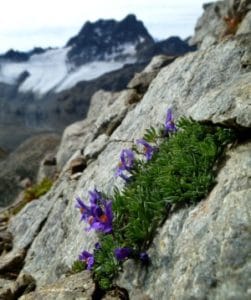 Linaria alpina on Piz Forun with Piz Kesch in the background. Photo: Sarah Burg/SLF, Switzerland.
Linaria alpina on Piz Forun with Piz Kesch in the background. Photo: Sarah Burg/SLF, Switzerland.
As a new Scientific Project Officer at the MRI coordination office in Bern, I hope to bring to MRI some of the experience and good mood from the Summit Flora Family and other networks I am involved in. This is what MRI also stands for: bringing mountain experts together and finding the right people to collaborate with. We are currently working on reconstructing our expert database to further facilitate this connectivity online and to allow new collaborations to establish and bloom. I hope to meet many of you at upcoming MRI meetings and, even more importantly, I hope that you will meet others and introduce new members to your scientific family.
Further reading:
- Steinbauer et al. 2018. Accelerated increase in plant species richness on mountain summits is linked to warming. Nature. 556, 231–234.
- To learn more about the work and data behind this paper, see blog post from Sonja Wipf here.
This post was written by Aino Kulonen, who works as a Scientific Project Officer at the MRI coordination office in Bern.
Cover photo: Summit Grasmugl in the Austrian Alps. Brigitta Erschbamer/University of Innsbruck, Austria.

